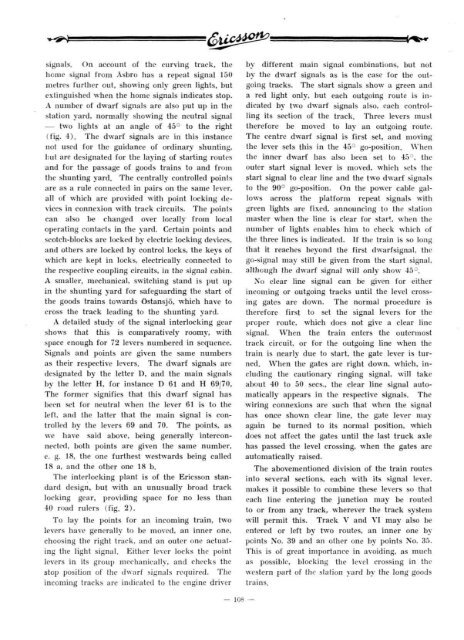Nos. 7 to 12 KARL FREDRIK WINCRANTZ. Managing Director of ...
Nos. 7 to 12 KARL FREDRIK WINCRANTZ. Managing Director of ...
Nos. 7 to 12 KARL FREDRIK WINCRANTZ. Managing Director of ...
You also want an ePaper? Increase the reach of your titles
YUMPU automatically turns print PDFs into web optimized ePapers that Google loves.
signals. On account <strong>of</strong> the curving track, thehome signal from Asbro has a repeat signal 150metres further out, showing only green lights, butextinguished when the home signals indicates s<strong>to</strong>p.A number <strong>of</strong> dwarf signals are also put up in thestation yard, normally showing the neutral signal— two lights at an angle <strong>of</strong> 45° <strong>to</strong> the right(fig. 4). The dwarf signals are in this instancenot used for the guidance <strong>of</strong> ordinary shunting,lint are designated for the laying <strong>of</strong> starting routesand for the passage <strong>of</strong> goods trains <strong>to</strong> and fromthe shunting yard. The centrally controlled pointsare as a rule connected in pairs on the same lever,all <strong>of</strong> which are provided with point locking devicesin connexion with track circuits. The pointscan also be changed over locally from localoperating contacts in the yard. Certain points andscotch-blocks are locked by electric locking devices,and others are locked by control locks, the keys <strong>of</strong>which are kept in locks, electrically connected <strong>to</strong>the respective coupling circuits, in the signal cabin.A smaller, mechanical, switching stand is put upin the shunting yard for safeguarding the start <strong>of</strong>the goods trains <strong>to</strong>wards Ostansjo, which have <strong>to</strong>cross the track leading <strong>to</strong> the shunting yard.A detailed study <strong>of</strong> the signal interlocking gearshows that this is comparatively roomy, withspace enough for 72 levers numbered in sequence.Signals and points are given the same numbersas their respective levers. The dwarf signals aredesignated by the letter D, and the main signalsby the letter H, for instance D 61 and H 69/70,The former signifies that this dwarf signal hasbeen set for neutral when the lever 61 is <strong>to</strong> theleft, and the latter that the main signal is controlledby the levers 69 and 70. The points, aswe have said above, being generally interconnected,both points are given the same number,e. g. 18, the one furthest westwards being called18 a, and the other one 18 b.The interlocking plant is <strong>of</strong> the Ericsson standarddesign, but with an unusually broad tracklocking gear, providing space for no less than40 road rulers (fig. 2).To lay the points for an incoming train, twolevers have generally <strong>to</strong> be moved, an inner one,choosing the right track, and an outer one actuatingthe light signal. Either lever locks the pointlevers in its group mechanically, and checks thes<strong>to</strong>p position <strong>of</strong> the dwarf signals required. Theincoming tracks are indicated <strong>to</strong> the engine driverby different main signal combinations, but notby the dwarf signals as is the case for the outgoingtracks. The start signals show a green anda red light only, but each outgoing route is indicatedby two dwarf signals also, each controllingits section <strong>of</strong> the track. Three levers musttherefore be moved <strong>to</strong> lay an outgoing route.The centre dwarf signal is first set, and movingthe lever sets this in the 45° go-position. Whenthe inner dwarf has also been set <strong>to</strong> 45°, theouter start signal lever is moved, which sets thestart signal <strong>to</strong> clear line and the two dwarf signals<strong>to</strong> the 90° go-position. On the power cable gallowsacross the platform repeat signals withgreen lights are fixed, announcing <strong>to</strong> the stationmaster when the line is clear for start, when thenumber <strong>of</strong> lights enables him <strong>to</strong> check which <strong>of</strong>the three lines is indicated. If the train is so longthat it reaches beyond the first dwarfsignal, thego-signal may still he given from the start signal,although the dwarf signal will only show 45°.No clear line signal can be given for eitherincoming or outgoing tracks until the level crossinggates are down. The normal procedure istherefore first <strong>to</strong> set the signal levers for theproper route, which does not give a clear linesignal. When the train enters the outermosttrack circuit, or for the outgoing line when thetrain is nearly due <strong>to</strong> start, the gate lever is turned.When the gates are right down, which, includingthe cautionary ringing signal, will takeabout 40 <strong>to</strong> 50 sees., the clear line signal au<strong>to</strong>maticallyappears in the respective signals. Thewiring connexions are such that when the signalhas once shown clear line, the gate lever mayagain be turned <strong>to</strong> its normal position, whichdoes not affect the gates until the last truck axlehas passed the level crossing, when the gates areau<strong>to</strong>matically raised.The abovementioned division <strong>of</strong> the train routesin<strong>to</strong> several sections, each with its signal lever,makes it possible <strong>to</strong> combine these levers so thateach line entering the junction may be routed<strong>to</strong> or from any track, wherever the track systemwill permit this. Track V and VI may also beentered or left by two routes, an inner one bypoints No. 39 and an other one by points No. 35.This is <strong>of</strong> great importance in avoiding, as muchas possible, blocking the level crossing in thewestern part <strong>of</strong> the station yard by the long goodstrains.— 108 —















